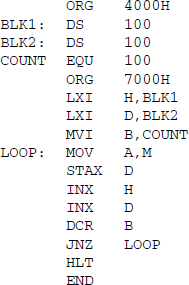B.1 Assembly Languages
There are five major advantages of assembly language, as compared to machine language:
- It uses mnemonic op-codes, we do not need to remember actual bit-patterns of the op-code. For example, referring to 8085 microprocessor, we can write ‘ADD A’ instead of ‘87’ in hex.
- Addresses can be given as symbolic addresses instead of numeric values. The assembler keeps track of the symbolic addresses by building a Symbol Table.
- It is more human readable.
- It makes available certain auxiliary operations like defining data and storage areas, setting the origin of a program segment, etc.
- It may provide address arithmetic, macros, scoping of identifier names, conditional assembly, ready-made macros or subroutine library for input/output, etc.
There are also certain disadvantages:
- You have to use an assembler to translate it.
- A programmer has to mentally translate the steps of the job to be implemented into a machine-specific sequence of operations.
- Many mundane and routine operations are to be implemented by the programmer.
- It is tedious and error-prone. Programmer productivity is very low.
- It is non-portable, i.e. if the CPU family is changed, complete recoding is required.
In this appendix, we shall use 8085 microprocessor machine code and assembly language as a running example. A typical small program in assembly language: this program copies 100-bytes from location 400016 to 406416. The program starts at location 700016.
B.1.1 Example Assembly Language
As indicated above, we shall use Intel 8085 microprocessor's assembly language as a running example.
Statements: The statements in this language are written one per line. The structure of a statement looks like:
<lable> : <Mnemonic> <blank/s> <operand1>
[ , <operand2>] [; <comments>]
Mnemonic may be a machine code or a pseudo-operation like data definition. Labels are upto 5 characters from set [A–Z@?0–9] with first character from [A–Z@?].
Pseudo-operations: There are several pseudo-operations available:
DB – define a byte or a sequence of bytes.
DS – define storage in terms of bytes.
DW – define 16-bit word data, order is Little-Endian.
EQU – equate a symbol to some value.
ORG – set origin of the following code.
Note that EQU requires a label (without colons), DB, DW and DS usually have label and ORG should not have a label.
Addresses: Addresses may be expressed in any of the following forms:
Decimal: Using digits [0–9], not more than 5 digits.
Hexadecimal: Using digits[0–9A–F], not more than 4 digits, followed by ‘H’ and starting with [0–9].
Octal: Using digits [0–7], followed by ‘O’ or ‘Q’.
Binary: Using digits [0–1], followed by ‘B’.
Symbolic: A data label defined somewhere in the program. Address arithmetic may be done – allowed operations are +, -, MOD, *. All address calculations using 16-bit numbers.
Offset from Location Counter (LC): LC is denoted by ‘$’ in the operand field. Offset can be positive or negative.

